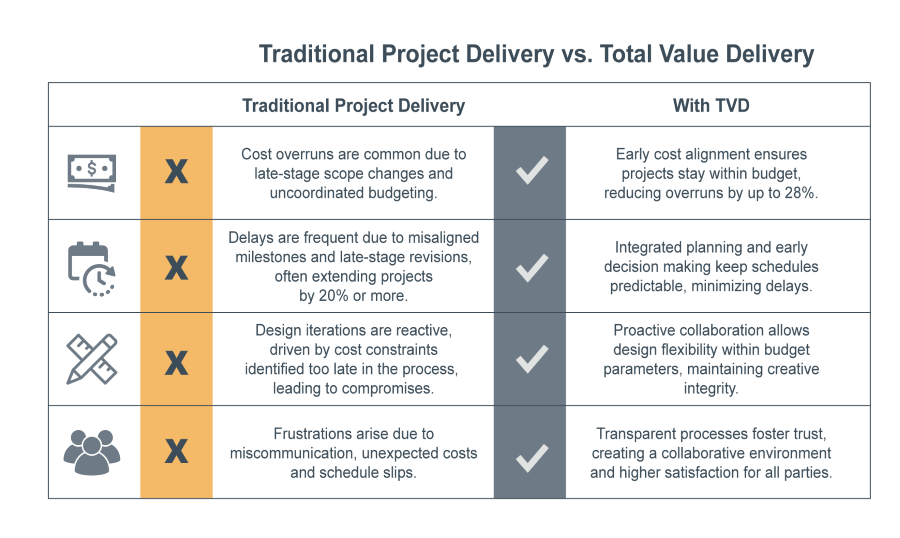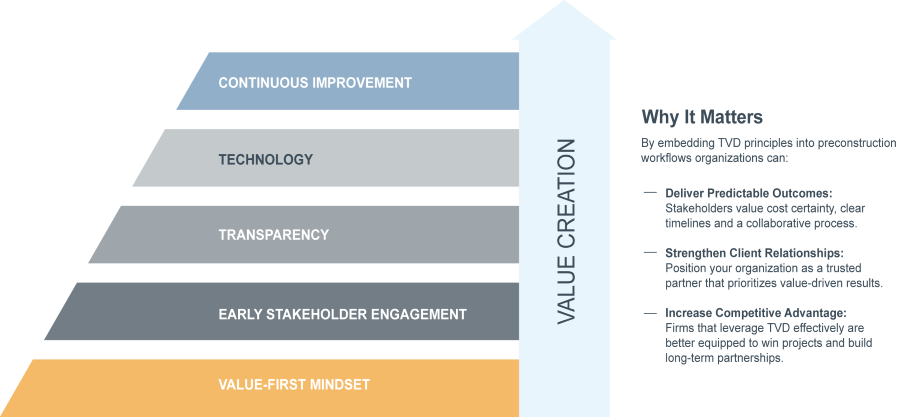Target Value Delivery: A Value Creation Framework for Every Project

Over the past decade, schedules have accelerated by 20% to 35%, while stakeholders demand more: tighter budgets, faster timelines and greater collaboration. For preconstruction teams, staying competitive means adapting to these new realities and taking the lead in creating value for clients.
Enter target value delivery (TVD): not just a methodology, but a transformative framework companies can use to align scope, budget and schedule to deliver measurable results. Whether you're managing the preconstruction phase of a $50 million ground-up hospital project or a small, corporate interiors renovation, TVD offers a universal, scalable strategy that sets your team apart by proactively leading clients to better outcomes.
This article explores why TVD is essential, how it applies to all collaborative delivery projects and how preconstruction teams can integrate it into their processes to meet evolving owner demands.
The Stakes: Why TVD is Essential Now
In today’s construction landscape, decisions made early in the project lifecycle create the largest cost savings and value gains. On the flip side, delays and misaligned priorities come with steep costs, including escalating prices, missed opportunities and fractured relationships. The below visual illustrates this reality.

Consider this key industry data:
- 85% of projects exceed budgets, with overruns averaging 28%. For a $50 million project, that’s $14 million in unexpected costs.
- Large projects take 20% longer than planned, delaying critical revenue generation for owners.
- Rework consumes as much as 30% of project budgets, wasting millions in labor and materials.
TVD directly tackles the above challenges by fostering collaboration, driving transparency and delivering predictable outcomes. Not just for RFPs or when explicitly requested, TVD amounts to a cultural mindset that contractors can leverage to lead and create value for clients.
Key Challenges Solved by TVD
Misaligned expectations
- The problem: Disconnected priorities between stakeholders often lead to scope changes, budget overruns and strained relationships.
- The solution: TVD engages owners, designers and contractors early, setting clear goals and aligning everyone in a shared vision.
Rework and inefficiencies
- The problem: Reactive processes result in rework that drains time and money.
- The solution: TVD’s structured, proactive planning minimizes redesigns, saving up to 30% in project costs and ensuring efficient workflows.
Siloed collaboration
- The problem: Poor communication leads to fragmented efforts, creating delays and frustration.
- The solution: TVD fosters a culture of teamwork, breaking down silos and building trust across all project teams.
The below chart illustrates how TVD outperforms conventional methods by addressing these pain points head-on.

Breaking the Myth: TVD Works for Only Collaborative Delivery Project
It’s a misconception that TVD only applies to large-scale or specific project types. On the contrary, TVD is applicable to any collaborative delivery project in which contractors can influence scope, design, schedule or budget. For example,
- Design-build hospital: TVD balances cost and quality, streamlines design/budget iterations and reduces both design schedule and construction risks.
- Small renovation project: TVD aligns scope with budget, reduces RFIs/ change orders/ rework and accommodates tight deadlines.
- Large infrastructure development: TVD manages complexity and diverse stakeholders through a collaborative framework.
By embracing TVD, contractors can differentiate themselves as leaders in driving client value, rather than waiting to be asked to implement it into projects.
Building a Culture of Value Creation
TVD isn’t just a tool; it’s a mindset. In applying it, contractors are uniquely qualified to lead the charge in creating value for clients, offering proactive solutions and helping them avoid potential issues. The TVD integration framework below highlights the principles that empower teams to do this effectively.
- Take the lead. Take the presumptive position that you as the contractor are in the best position to lead the overall coordination and execution of the preconstruction phase. Demonstrate your confidence and competence to clients early and often, and avoid a vacuum of leadership where often OAC stakeholders can be left wondering who is ‘driving the bus’.
- Engage stakeholders early. Proactively facilitate owner objectives and program alignment workshops to clearly define measurable goals. Leading these discussions positions your team as a trusted advisor to owners and designers.
- Adopt a value-first mindset. Develop value optimization options on every project to demonstrate you understand your clients project objectives and are advising them in their best interests - whether it’s by lowering lifecycle costs, delivering innovative design solutions for end-user functional experience, reducing delivery risk or achieving better schedule outcomes.
- Emphasize transparency and leverage technology. Utilize real-time dashboards and shared platforms to ensure consistent, accessible data that enables informed decision-making, driving scope, schedule, and cost certainty. Advanced technologies enhance this transparency:
- Clean data with AI-driven analytics for proactive cost modeling, risk assessment, and predictive forecasting, using historical data and machine learning to identify trends, optimize budgets and mitigate potential overruns.
- BIM and VDC for virtual simulations that identify constructability issues early, improving coordination and reducing rework.
- Digital twins for seamless integration of design, cost, and schedule data, enabling real-time project adjustments and performance tracking.
- Commit to continuous improvement. Integrate “lean” principles and post-project reviews to refine processes and remain competitive. Success isn’t just about adopting TVD but about evolving it to fit your team’s needs and your clients’ expectations.

What Happens If You Ignore TVD?
Without TVD, teams risk:
- Missing opportunities: Outdated methods lead to overspending and missed deadlines.
- Frustrating stakeholders: Budget overruns and poor communication erode trust.
- Falling behind competitors: Firms that fail to innovate lose out to teams that deliver predictable, value-driven results.
The construction industry is at a crossroads. As expectations rise, preconstruction teams must adapt to stay competitive. Ask yourself:
- Are your workflows designed to deliver cost certainty, schedule alignment and seamless collaboration?
- How effectively are you engaging owners and designers early to establish shared goals?
- Do you have the tools and strategies to exceed stakeholder expectations consistently?
- Is your team positioned to compete with the best-in-class preconstruction groups?
If these questions give you pause, it’s time to take action.
How FMI Can Help
FMI offers tailored solutions to help you elevate your preconstruction operations, including:
- Preconstruction audits: Workflow evaluations to optimize efficiency and align your operations with industry best practices
- TVD integration workshops: Hands-on sessions to help you embed TVD principles into your processes, fostering collaboration and alignment
- Business development + preconstruction + operational assessments: Comprehensive evaluations to ensure your team delivers best-in-class results to owners and designers
Remember, by embracing TVD, contractors can:
- Align with stakeholder goals and exceed expectations
- Establish themselves as trusted advisors and leaders in project delivery
- Create a culture of proactive value creation, ensuring long-term success
To reiterate, TVD isn’t just about methodology; it’s a strategic approach that empowers contractors to lead, innovate and deliver value for every stakeholder. Now is the time to adopt this mindset, redefine excellence in preconstruction and set a new standard for value-driven project delivery.



